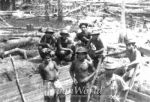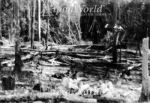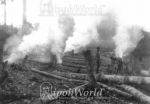We've tried to ensure the information displayed here is as accurate as possible. Should there be any inaccuracies, we would be grateful if you could let us know at info@ipohworld.org . All images and content are copyright.
(Please click on the thumbnail for a bigger image.)
Fort Kemar - The Building Of A Malayan Jungle Fort - Part 5



The day after receiving our first airdrop of food, supplies and building equipment, work started in earnest. My Malays, working alongside the Asli, started to cut, clear and burn the smaller trees and undergrowth with axes and parangs whilst, at the same time, those Asli skilled in the use of the beliong, started on the huge jungle trees - some of them 200 feet high and many with large projecting butresses spreading to a circumference thirty to forty feet and resembling, at the base, the fins of a rocket. The beliong is a light axe with a small razor-sharp blade, rather like the blade one sees on a stone-age axe, tied with rattan to the end of a curved 2 or 3 foot long flexible stem, cut from a sapling and carved at the end to form a cylindrical grip. In the hands of an expert it is unbelievably effective and two skilled men cutting with absolute precision and each using his beliong like a whip were able to cut down the very largest jungle tress in a remarkably short time. Their technique was to cut the trunk by encircling the tree with a bamboo platform just below the buttresses and for the two men to work on on opposite sides of the tree. The problem with this method was that by cutting above the buttresses, a very large stump remained which had to be removed by another method - explosives.
Our expert in the use of explosives was Captain Gordon Smith - a Royal Engineer officer serving with the SAS. and he and I blew up anything which needed to be blown up. It was great fun, and although it was not my function, I wasn`t going to miss it. We used Composition C-3, a plastic explosive which looks like sticks of marzipan wrapped in greaseproof paper. It has the consistency of plasticine, is easily moulded into any shape or packed into any hole and it was ideal for blowing large tree stumps out of the ground. It was activated using a bobbin-shaped guncotton primer with a detonater pressed into it and then a length of burning fuse, long enough to keep us out harm`s way when fired. We also used Cordtex - an explosive in the form of a white plastic cable. Using this we were able to make a `daisy chain`, or ringmain, of C-3, rather like an electric circuit, and blow up a number of connected charges simultaneously. The vast explosion caused by blowing up a whole series of large trees or stumps instantaneously, caused huge merriment and awe amongst the Orang Asli who would dance about and scream with laughter like children, as they watched from the protection of trees and trenches. It was also possible to cut small trees by wrapping a length of Cordtex around round them and detonating it.
An interlude in my own work at the fort presented itself on the 2nd March when two Orang Asli came running into the camp from their longhouse down the river to tell me that one of their men had been attacked and badly injured by a bear and they needed our help. It was an incident that was to end in a Buster Keaton farce! The brown bear of the Malayan jungle is not huge - fully grown, it is about the size of a man; it is seldom seen and poses little danger - but unfortunately for him, the injured man had stumbled across a female with cubs, and in this situation the Malayan bear - in common with the females of all species - is very dangerous. I immediately took a small patrol with food for a couple days and we arrived at the Asli ladang by late afternoon and found that the injured man had been almost scalped by the bear`s claws. Whilst my medical orderly attended to his injuries and I radioed for a helicopter casualty evacuation for the following day, the men prepared to make camp on a flat sandy area beside the river and below the longhouse, which was a little way up the hill. The wild ginger, which was the only thing growing on the site, was easily cleared and we started to unpack our kit, light fires to prepare our evening meal and settle down for the night. Then, all hell broke loose. Two men tore into our camp shouting
“Gajah! Gajah! Chapat, mari ka sahaya punya rumah, lari lari chapat”
Elephant, elephant, come to my house, run, run, hurry up! We wasted no time in unceremoniously stuffing anything we could lay our hands on into our packs, and, with the rest in our arms, fled, like a pack of tinkers, to the longhouse. The men were given an area at one end of the longhouse to sort out their kit and put down their blankets, but I was given a very small room which projected from the rear of the house. Thus far, no elephant. Then, just after I had fallen asleep, I was awakened by screaming and shouting and felt the floor under me trembling as the earth shook beneath the building. It took no stretch of the imagination to know that the elephant had not only arrived, but had arrived at the rear of the building and was very close to my projecting room. Then the entire population of the longhouse, after making flaming torches out of split bamboos which they had plunged into the fire which burned in the middle of the floor on an earth hearth, hurtled out of the building, waving their torches, banging tin cans and shouting abuse at the elephant who, upon finding there was no female elephant to be found after all, retreated back into the jungle. Having joined in the general mayhem, my men and I returned to our blankets for a good night`s sleep. Or so we thought! For, about an hour later the same thing happened again - my floor shook, the earth trembled and there was great deal of thudding and trumpeting outside, seemingly uncomfortably close to my room and with the same result. This time however, the Orang Asli appeared rather less interested, even rather bored. Fewer turned out, the flaming torches had become burning stumps and the initial `general mayhem` might be better described as a `shooing away`. Anyway, it did the trick and Jumbo retired. Or, sort of. He continued to snuffle, grunt and thud around for the rest of the night, seemingly much too close to where I lay, but no one could be bothered to get up any more, and, whilst everyone else slept the sleep of the dead, I lay awake for the rest of the night listening to the thud and rumbling of this very large elephant convinced that at any moment he would be joining me in my very small sticking-out-room. I was glad and relieved to seeing the light of the dawn and, after breakfast, I was called by the Asli headman to go down to see what was to have been our campsite, to find everything, including any tins we had left behind, totally flattened. The casevac helicopter arrived mid-morning and our casualty was safely removed to Ipoh hospital. There were times during the night when I thought I might be joining him!
The photographs show, on the left, some of the Malay police constructing defences and then centre and right, various scenes relating to the clearing of the site before the Fort could be built.
To go to Part 6, click here.